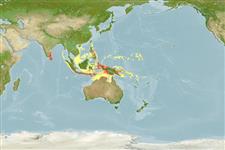ইলাসমোব্রাঙ্কি (হাঙ্গর এবং রে) (sharks and rays) >
Carcharhiniformes (Ground sharks) >
Atelomycteridae (Coloured catsharks)
Etymology: Atelomycterus: ateles (Gr.), imperfect, unfilled or exempt; mycteros (Gr.), nostril, referring to lack of posterior nasal valve. (See ETYFish); baliensis: -ensis, Latin suffix denoting place: Bali, Indonesia, only known area of occurrence. (See ETYFish).
More on authors: White, Last & Dharmadi.
Environment: milieu / climate zone / depth range / distribution range
বাস্তুসংস্থান
সামুদ্রিক তলদেশ বিহারী. Tropical
Western Pacific: known only from the Indonesian island of Bali.
আকৃতি / ওজন / Age
Maturity: Lm ? range ? - ? cm
Max length : 47.4 cm TL পুরুষ/ লিঙ্গ অনিধর্ারিত ; (Ref. 54850)
A relatively small (max. size 474 mm TL) Atelomycterus with the following combination of characters: relatively short preoral length, 4.0-4.6% T; short interdorsal space, 11.6-12.9% TL; high pectoral-pelvic to pelvic-anal ratio 1.28-1.48; dorsal fins weakly falcate, with posterior margins vertical or sloping anteroventrally from fin apices; prebranchial denticles strongly tricuspid with narrow, elongate medial cusps; claspers of adults short, not stubby, not tapering sharply distally, outer length 8.3-9% TL, base width 5.4-6.3% of outer length; clasper glans covering more than half of clasper; cover rhipidion relatively narrow; rhipidion large, relatively low, and only partly concealed by cover rhipidion and exorhipidion; exorhipidion small with proximal end well behind distal end of cover rhipidion; total vertebral centra 154-163, precaudal centra 101-106; dorsal surface with well-defined dark saddles consisting mainly of four, partly coalesced, diffuse-edged, dark brown blotches; white partly coalesced, diffuse-edged, dark brown blotches; white spots absent from body and rarely on fins; inner margin of pale tips of dorsal fins orientated almost vertically; upper pectoral fin lacking a broad, sharply defined whitish margin.
Biology unknown; presumably reef-dwelling, inhabiting holes and crevices on reefs, like other related catsharks. Presumably oviparous. Diet probably dominated by small invertebrates . Caught irregularly by fisheries operating over coral reefs. Utilized for its meat but of limited value (Ref.58048).
Life cycle and mating behavior
পরিপক্কতা | প্রজনন | ডিম ছাড়া | ডিমসমূহ | ডিম্বধারন ক্ষমতা | শুককীট
White, W.T., P.R. Last and Dharmadi, 2005. Description of a new species of catshark, Atelomycterus baliensis (Carcharhiniformes: Scyliorhinidae) from eastern Indonesia. Cybium 29(1):33-40. (Ref. 54850)
IUCN Red List Status (Ref. 130435)
Threat to humans
Harmless
Human uses
আরো তথ্য
প্রচলিত নাম সমূহপ্রতিনাম সমূহবিপাকশিকারী প্রাণী সমূহপরিবেশ বিষাক্ততাবিদ্যাপ্রজনন পরিপক্কতা ডিম ছাড়া ডিমের সংগ্রহ ডিম্বধারন ক্ষমতা ডিমসমূহEgg development
Age/Sizeবৃদ্ধিLength-weightLength-lengthLength-frequenciesমরফোমেট্রিক্সবহিঃ অঙ্গ সংস্থানশুককীট শুককীটের সত্রিুয়তা নির্বাচন প্রাচুর্য BRUVS
সূত্র সংখ্যা এ্যাকুয়াকালচার (জলজ পালন) এ্যাকুয়াকালচার নকশা বংশ বংশানুগতিবিদ্যাElectrophoresesউতরাধিকার সুত্রে পাওয়া যোগ্যতারোগ প্রক্রিয়াজাতকরণ NutrientsMass conversion
সহযোগী ছবি সমূহStamps, Coins Misc.শব্দ ক্রোমোজোমের ধরণ গতি সাতাঁরের কায়দা ফুলকা এলাকাOtolithsমস্তিস্ক সমূহদৃষ্টি
হাতিয়ার
Special reports
Download XML
ইন্টারনেট সুত্র
Estimates based on models
Phylogenetic diversity index (Ref.
82804): PD
50 = 0.5156 [Uniqueness, from 0.5 = low to 2.0 = high].
ট্রফিক পর্যায়ে (Ref.
69278): 3.7 ±0.3 se; based on size and trophs of closest relatives
স্থিতিস্থাপক (Ref.
120179): নিম্ন/ , সর্বনিম্ন প্রজন দ্বিগুনের সময় ৪.৪-১৪ বৎসর (Low fecundity (RF)).
Fishing Vulnerability (Ref.
59153): Moderate vulnerability (37 of 100).
